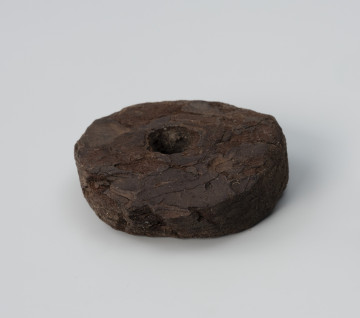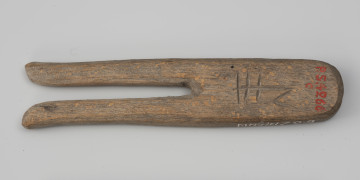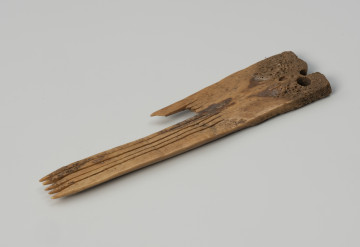
Float
801 — 1201
National Museum in Szczecin
Part of the collection: Middle Ages
Thousands of artefacts were recovered during the archaeological excavations carried out between 1986 and 2001 within the boundaries of Szczecin's Podzamcze. The largest number was provided by dig VI established within quarter 5. One of these is a spindle-shaped float made from a single, rather large piece of bark – most likely pine. There are two holes at both tapered ends, but they are perfectly visible at one end and poorly legible at the other due to the loss of the tip. It is not known whether the breakage occurred while the float was still in use and was the cause of its abandonment, or whether it occurred later, as a result of sub-depositional processes.Simple to make, bark floats were produced in home workshops for personal use. A knife was used to separate the bark from the trunk, give it the required shape and drill holes in the ends for the ropes with the tip of the knife. Similar objects are found in large numbers in waterside sites whenever the conditions there allowed for the preservation of organic raw materials. The presented piece is an example of a double-sided, two-hole float. It is believed that this type of object was used to float the top edge of the net in the water, to which it was attached by a rope. Special weights were attached to the bottom edge of the net. Depending on the species of fish to be caught, the net was sometimes placed at different depths – closer to the surface or to the bottom. Sławomir Słowiński
Author / creator
Object type
fishing net buoy
Technique
planing
Material
tree bark
Origin / acquisition method
legal transfer
Creation time / dating
Creation / finding place
Owner
Muzeum Narodowe w Szczecinie
Identification number
Location / status

801 — 1201
National Museum in Szczecin

1890 — 1950
National Museum in Szczecin

1176 — 1200
National Museum in Szczecin
DISCOVER this TOPIC
Castle Museum in Łańcut
DISCOVER this PATH
Educational path